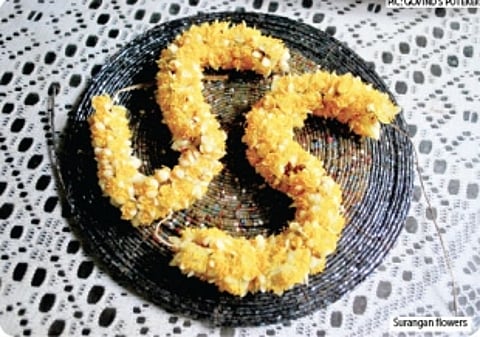

The roadside vendor, Urmila Gaonkar from Mayem, selling fragrant flowers with golden stamens, Surangan (Mammea suriga) reveals that she has never seen the tree although she sells the flowers procured from a florist in Chimbel. Vandana Chari, who was born in Badem, Salvador do Mundo, would frequent the hillock in the morning and in the evening along with siblings and neighbours to collect flowers during her school days. She was not surprised by the demand for the flowers but was simply dumbfounded at the price they fetch now. Times have changed so fast and also the cost of these seasonal flowers. Year after year, people in the villages wait for the summer season as it is the time after winter season, when spring brings bounties of nature. Economic activity picks up for the villagers, no matter how small, as it is time to harvest seasonal flowers and fruits. Apart from getting a few pocket coins from our parents, any additional income would be our earnings from our effort. Who doesn’t love to be on their own feet, no matter how little one would earn? In that sense, every person will have their own stories of yore to tell about their early days of life’s struggle and the nostalgic feeling. Whether it was at dawn or just before dusk, young girls and boys in the village would go to the backyard hill. It was to collect lesser-known berries like Chunna, Kanna and Jamla, and flowers such as Vhovla and Surangan which had a great demand. Passing underneath any one of these plants, the fragrance was simply exceptional. Offering garlands of these flowers are common during the season as people wait for these flowers to bloom. Just before going to school or later in the evening young villagers would head to the hill and pluck the flowers. Elders in the family would make a garland out of the flowers. There was virtually a competition to collect the small flowers by climbing a tree by taking all the possible risks. One had to take care on the ground too for the odd serpent that they would encounter quite often. Each one would reserve a branch and no one else would question the other. It was simply a joy and everyone hoped to collect large quantities of flowers. Some would collect flowers in cloth bags (plastic carry bags didn’t exist then) and others would collect the tiny buds in every pocket of their shirt and pant that was packed to capacity. Vandana’s brother, Navanath Chari, remembers those days on the hill and atop the tree branches. “We would carry a lighted candle in a coconut shell and wade through the footpaths in the wee hours. We were so used to collecting the buds in the dark just by sensing them based on their size and we would pluck only those buds that would bloom,” he says. “Banana fibre was used as a string to make the garland. We would make many garlands and one of us would go walking the village lanes to sell them. Many people were regular buyers,” he adds. It was the time when a garland of Vhovla or Surangan would cost 20 paise to a maximum of 50 paise in the seventies and eighties. And, that was a good enough sum to buy personal items and some snacks from the local kiosk (Gadah). Shev Ladoo or Chikki would cost just about five to ten paise and all the small needs of kids who would frequent the hills for the prized flower would be met by selling those garlands of hope and strong fragrance. Now the garland sells at a royal price of Rs 100. It’s a gold standard jump for flowers as the first offering is often made to a local temple deity and deities at home. Women adorning it in their braid during festivals is quite a pleasant sight, even today. Everything was going perfectly fine for decades as young members would reach adulthood and still their aspiration would continue for the flowers. Religion didn’t matter as there was always a family atmosphere between all. However, one incident was a turning point and no one ever dared to climb the Surangan tree again. Jack Fernandes recollected that one tragic morning when he along with his cousin Planton, who were both studying in Class 6 had slipped out of their house without their parents noticing them as the vegetation was emerging in the twilight of the day. Some of the youngsters would climb as high as they could on the branches and collect the flowers from the furthermost twig. Others, who wouldn’t dare, collected from branches close to the ground or standing atop the compound wall separating any two properties. People in the village still remember that morning more than thirty years back, when Surangan blooms bringing back the memory of little boy Planton, who had fatal fall from one of the trees and the dreams of every young person in Badem lay shattered and the few paisas that empowered them was lost forever. As a mark of respect for the budding child, they never climbed the tree again. Though the fragrance of Surangan keeps calling, the fast disappearing vegetation for real estate projects, the very survival of the trees is seriously at stake even as memory lingers!